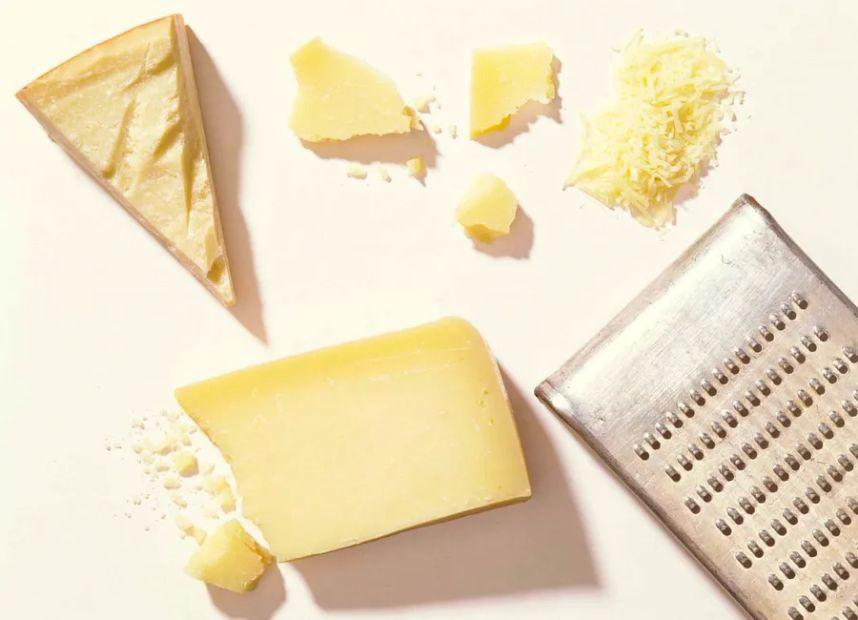How Does Parmesan Compare to Parmigiano Reggiano?

Whether you're looking for a flavorful cheese to enhance your pasta, pair with a rich Italian red, or simply enjoy as a savory snack—nothing beats a good Parmesan.
Yet, navigating the price and quality differences between Parmesan-style cheeses like Grana Padano and Parmigiano Reggiano can be a real puzzle when you're in the cheese aisle.
Though all of these cheeses belong to the "grana" family, each offers a distinct flavor and unique production method. The term "grana" refers to the process of milling curd into rice-sized grains, which releases moisture and results in a hard, dry cheese. The extended aging process also makes Grana-style cheeses lactose-free.
So, when you're choosing Parmesan-style cheese, which one should you go for? To guide you, we've consulted top Italian cheese experts to explain the differences between Parmesan, Grana Padano, and Parmigiano Reggiano.

What Is Parmesan?
As per the US Code of Federal Regulations, Parmesan must be a cow's milk cheese with a "granular texture" and a "hard, brittle rind," aged for a minimum of 10 months. Additionally, the curd should be cut into pieces no larger than the size of wheat kernels.
Parmesan can be produced using cream, skim milk, concentrated skim milk, nonfat dry milk, or water to rehydrate any concentrated skim or nonfat dry milk. Unlike Grana Padano and Parmigiano Reggiano, which we explore further below, Parmesan can also be made with pasteurized milk—though some believe this leads to a less flavorful cheese.
There are no official regulations specifying where Parmesan cheese must be made. However, purists sometimes criticize cheeses labeled Parmesan that aren't from Italy, dismissing them as inferior. For many years, Italian immigrants in the U.S. struggled to find authentic Parmesan, either because it was too costly or unavailable due to wartime or economic challenges. This is how American-made Parmigiano came to be.
While Parmesan might not be the first choice for your cheese board (unless you're already a fan), it is always a great option for cooking or grating over pasta.

What Is Grana Padano?
"Grana Padano is nearly a millennium old," says Nicola Cesare Baldrighi, President of the Consorzio Grana Padano. "It’s still produced using the same traditional method pioneered by the Cistercian monks centuries ago."
Grana Padano is a Protected Designation of Origin (PDO) cheese, meaning it must adhere to strict guidelines and be produced in a designated region to carry the name. It is crafted in the Po River Valley using partially skimmed raw milk from cows that primarily graze on grass or "preserved fodder."
Grana Padano is the world's top-selling PDO cheese, with around 24 percent of Italy’s total milk production dedicated to its creation.
Grana Padano is available in three distinct aging profiles:
- Between 9 and 16 months: Softer, pale yellow, milky, and delicate flavor.
- Over 16 months: Crumbly, with a crystalline structure. Creamer flavor with notes of hay.
- Riserva (over 20 months): Grainy, with a flaky structure. Aromas of butter, nuts, and dried fruit.
Thanks to its variety of aging options, Grana Padano is not only perfect for cooking but also a great cheese to enjoy on its own, especially the exclusive Riserva Grana Padano.

What Is Parmigiano Reggiano?
Often dubbed "The King of Cheese," Parmigiano Reggiano is one of the world’s oldest cheeses. The monks who first crafted it sought to make a cheese that would last longer. They achieved this by drying the cheese mass and increasing the wheel size, which allowed it to keep well and travel far from its production area, according to Nicola Bertinelli, president of the Consorzio Parmigiano Reggiano.
The earliest written reference to Parmigiano Reggiano dates back to a 1254 notarial deed that mentions "caseus parmensis," or cheese from Parma. In Giovanni Boccaccio’s *Decameron*, a mountain of "grated Parmesan" is described, on which "Macaroni and ravioli" were rolled, indicating its long history in Italian cuisine.
Parmigiano Reggiano is made in nearly the same way it was nine centuries ago, thanks to its rigorous PDO regulations. "It’s crafted using the same ingredients (milk, salt, and rennet), with traditional methods that have changed little over the centuries," explains Bertinelli. To earn the name Parmigiano Reggiano, only raw milk from grass- or hay-fed cows in the regions of Parma, Reggio Emilia, Modena, Mantua, and Bologna can be used. The cheese must also be made, packaged, and pre-grated in these specific areas of origin.
The regulations protecting the name are so strict that in 2008, the EU Court ruled that the term "Parmesan" can only be used for PDO Parmigiano Reggiano cheese.
Parmigiano Reggiano is available in four distinct aging profiles:
- 12-18 months: Aromas of yogurt and fresh fruit. Crumbly, delicate.
- 22-24 months: Grainy texture, with balanced flavors of broth and dried fruit.
- 30-36 months: Crumbly, grainy. Notes of spice, toasted nuts, and beef broth.
- More than 40 months: Layered, complex, very hard texture.
Some premium varieties of Parmigiano Reggiano include Vacche Rosse — highlighted in Netflix’s *Salt, Fat, Acid, Heat* — made exclusively from the milk of the Reggiana Red cow, and Solo di Bruna, crafted solely from Swiss Brown cow's milk.
Parmigiano Reggiano is perfect for grating over pasta, soups, and salads, but it’s also great for snacking, especially when paired with Prosciutto di Parma, which comes from pigs fed the leftover whey from making Parmigiano Reggiano.
Evaluation :
5/5



